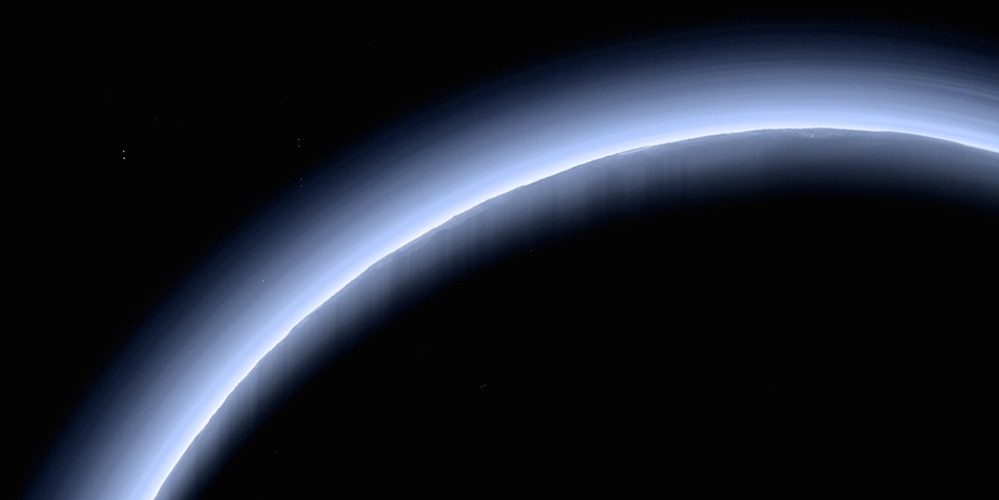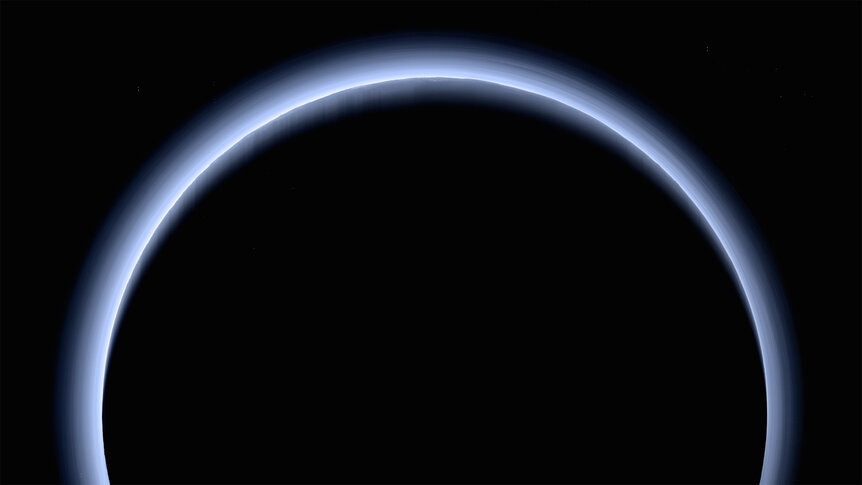Goodnight, Pluto

On July 14, 2015, just after noon UTC, the small space probe New Horizons shot past Pluto at 50,000 kilometers per hour. It took images and data as it barnstormed the tiny world just 12,500 km above the surface, and then, as it passed what for many is the final outpost of the planets, the spacecraft spun around to look back on its target, lit from behind by the Sun.
And what it saw was awe.
That image is a newly reprocessed mosaic comprised of six grayscale images taken with New Horizons’ high-resolution camera (which only “saw” shades of gray), with the color added using information from a lower-resolution camera that was color-sensitive. The six frames were taken a little over three hours after closest approach, and all within a half hour of each other. This new mosaic was recently carefully constructed by Tod Lauer and Alex Parker, who painstakingly matched the pieces together and mapped the colors to them.
What you are seeing is the night side of Pluto, backlit by the Sun. Pluto is over 30 times farther from the Sun than Earth is, so all the time it was traveling from Earth to Pluto, New Horizons was seeing Pluto’s lit side, the day side. Once it passed Pluto and spun around, it was seeing the night side, unlit, the Sun nearly five billion kilometers distant.
With Pluto darkened, the fainter features around it were easier to see. And that ring of light in the image? That’s Pluto’s atmosphere, an ethereally thin whisper of gas. The sunlight is so dim at the inner solar system’s edge it can only feebly free nitrogen ice and other molecules on the surface and turn it into a gas, barely managing to create one hundred-thousandth the pressure we enjoy here on Earth.
But it’s enough. Pluto’s weak gravity can barely hold on to this gas, so the atmosphere puffs up, ironically reaching much higher altitudes than our thicker atmosphere does on Earth. And it’s blue! That’s because it’s mostly nitrogen, just like Earth’s air (ours is about 78% nitrogen and 21% oxygen). Nitrogen molecules allow longer wavelength redder light to pass right by them, but scatter shorter wavelength blue light in every direction. This spreads the blue out, creating the cerulean sky.
Another stunning feature to Pluto’s air is the layering you can see to it; there are dozens of thin strata visible. Those are haze layers, thin blankets of what may be organic molecules created as ultraviolet sunlight and zippy subatomic particles called cosmic rays break down simple carbon-based molecules on Pluto and build up more complex ones like acetylene and ethylene. There are dozens of such layers, apparently buoyed up the air and shaped by waves of winds in Pluto’s atmosphere (called gravity waves; they roll up and down like water waves in your bathtub). Those layers reach heights of hundreds of kilometers.
The detail in the image is stunning; look at the highest resolution version and scroll around. Around the top of the curve of Pluto you can see faint dark streaks pointing down. Those are shadows of surface features like hills and mountains! For them, the Sun is near the horizon, so the shadows are long. If you were standing there you’d see them stretching across the sky, converging toward the horizon opposite the Sun, a magnificent display.
What would that look like? Something like this, I’d gather:
That image was taken by my friend Rob Sparks in Arizona, and shows much the same thing. You can see the shadows across the sky, and due to perspective they converge on the vanishing point opposite the Sun. The technical term for this phenomenon is anticrespuscular rays (when you see them fanning out from the Sun, itself, they’re called crepuscular rays), and, if you want to impress people at cocktail parties, you can refer to them as anticrepuscular rays converging on the antisolar apex. They’re pretty common, and if you pay attention to the sky, you’ll be graced with seeing them fairly often.
And the thing that gets me the most? When I first saw these original images after the Pluto encounter, I assumed the sky would look black if you were standing on the surface. The air is so thin, the scattered light would be too faint to see. But then Tod Lauer (yes, the same guy who worked on the picture here) sent me a note saying that, especially at sunrise or sunset, those haze layers and atmosphere should be visible to someone standing there
That is amazing. And I don’t mind being wrong; I learned something, and what I learned what something utterly cool. I think of that when I see this picture, now.
And when I do look at it, I’m also torn by the irony of it. Pluto is so terribly far from the Sun, and so vastly different than our own world. Earth’s atmosphere, its oceans, would be frozen solid there, harder than granite, and the composition of the Pluto’s surface is alien to our own. It’s tiny, smaller than Earth’s Moon, littered with impact craters and weird features still difficult to entirely explain.
And yet, here, we see it ringed with an atmosphere a friendly blue, that, despite its chill and underlying alien nature, is a poetic reminder of home. While people may argue over whether Pluto is a planet or not, I shrug that off; a distraction from its true nature: That of a world, a place, a thing that we can see and visit and examine and try to understand. And in this image, this bittersweet farewell photo of Pluto taken after New Horizons had performed its mission, this is strikingly, and literally, brought home.
[Postscript: In truth, New Horizons is not yet done. On January 1, 2019 it will pass within a few tens of thousands of kilometers of 2014 MU69, a small (few-dozen-kilometers-wide) body that’s a true member of the distant, frigid Kuiper Belt, a collection of icy/rocky chunks left over from the formation of the solar system itself. We’ve never seen one in situ up close before, so once again New Horizons will pass into a new frontier, breaking through a barrier that’s existed for as long as we’ve gazed up into the sky.]




























